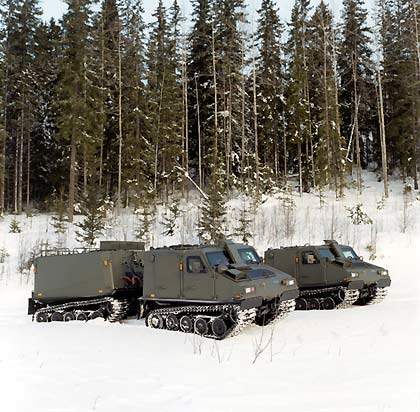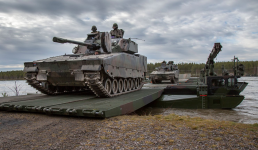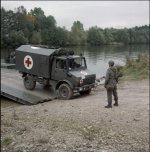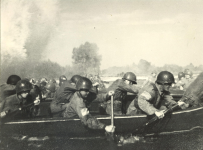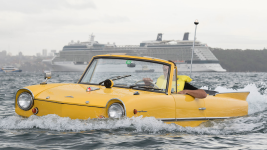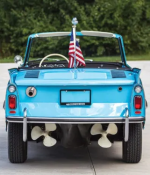You may be more impressed with the ability of the M113 to tackle water obstacles than those who drove/rode in the aluminum boxes. That's not to say it wasn't a good vehicle for its time and place, but it did have limitations.
As for preparation/operation for water obstacles, the "warnings" in the section of
TM 9-2350-277-10 (OPERATOR’S MANUAL CARRIER, PERSONNEL, FULL TRACKED, ARMORED M113A3) dealing with water operations should give you some idea about the precautions that we used to take for relatively simple water/river crossings.
Theses are just some of the "warnings" for water operations found on pdf pages 397 to 432 of the linked TM. Granted it it a more recent manual and thus issued during a more safety conscious environment. I don't remember such a comprehensive operator's manual when I learned to operate the APC in the 1970s, but the warnings about water crossing and the precautions (
prep of veh, pers, safety staff and entry and exit banks) needed before attempting were just as numerous.
FORD WATER UP TO 40 INCHES DEEP
WARNING When water depth is unknown or deeper than 40 inches (3.4 feet), do not attempt to ford stream. Carrier may sink and personnel could drown. See task: PREPARATION BEFOREWATER OPERATION (WP 0066 00).
PREPARATION BEFORE WATER OPERATION WARNING Do not perform water operations without flotation bag properly secured and opened. Before starting water operations, perform all carrier PMCS and the Preparation Before Water Operation. Pay particular attention to drain plugs and access covers which must be in place, straight and tight.
Failure to do this could result in carrier sinking and loss of life.
Carrier could sink and personnel could drown without track shrouds secured in place. Carrier can have loss of steering without track shrouds. Do not attempt water operation without them
If bilge pumps do not work during water operations, carrier can sink;
personnel can be killed. Do not attempt water operations if bilge pumps do not operate.
When power plant door detent screw is missing or does not rub against handle when handle is moved to closed position, power plant door can open and take in water during water operation.
Carrier can sink and personnel can drown. Do not attempt water operations when detent screw is missing or improperly adjusted.
Unsecured stowage/load can shift or fall during carrier motion.
Personnel can be injured. Secure all stowage/load to eliminate movement regardless of carrier attitude, including inverted position.
Carrier can sink and personnel can drown when maximum load (weight of personnel, fuel and/or cargo) is exceeded and/or not properly distributed. Distribute weight of cargo and/or personnel evenly before entering water, per load plan in WP 0106 00
Displaced or damaged ramp and personnel door seals may let water leak into cargo area.
Personnel can drown. Check door ramp and seals before closing doors. Do not attempt water operation if there is leakage.
If hatches are closed during water operations,
carrier can sink and personnel can be trapped inside and drown. All hatches must be in open position with locking pins installed before water operations.
Carrier can sink during water operations when trim vane is not extended and locked in place and flotation bag is not open.
Personnel can be killed. Before entering water, extend and lock trim vane in position for water operations. Open and properly secure flotation bag. NOTE Carriers can float, however, swimming is not allowed. Since the bottom, beneath the surface of the water may have holes, gullies, soft spots and other hazards, carriers must be prepared to float and move away from dangerous areas.
If carrier sinks, personnel can drown when safety belts are fastened. Release safety belts before starting water operations.
Exceeding terrain and water obstacle limits greatly increases chance of sinking. Entering the carrier in water containing a large amount of debris or ice, water moving faster than 2 mph or with waves above 6 inches is high risk. Do not enter the carrier in water containing large amounts of debris, water current greater than 2 mph, or with waves over 6 inches high. Do not exceed limits.
The carrier could sink and personnel can drown.
Do not jump the carrier into the water.
This could cause the carrier to sink and result in injury or death to personnel. Do not stay in the water if carrier bilge pumps are pumping a steady stream for more than 30 seconds.
Personnel in the carrier should remain still and not move during water operations. Movement may upset the balance of the carrier, causing death or injury
Carrier can sink and personnel can drown if dip (trial water operation) exercise is not conducted before actual water operation in streams or rivers with personnel aboard.
Carrier can sink during water operations when trim vane is not extended and locked in place, and engine grille water barrier is not erected.
Personnel can be killed. Before entering water, extend and lock trim vane in proper position for water operations with flotation bag secure. Erect engine grille water barrier.
Carrier can sink and personnel can drown when maximum load (weight of personnel and/or cargo) is exceeded and/or not properly distributed. Do not operate carrier in water if water is above water level strip on trim vane.
Carrier can sink and personnel could be injured or killed if carrier enters or exits on a slope greater than 30% grade. Do not exceed a 30% entry/exit slope.
Enter water head on. Do not attempt to back-up into water.
Personnel could be injured or killed.
Personnel should not move during water operations.
Personnel movement may upset the balance of the carrier causing death or injury.
Sudden responses to acceleration and deceleration due to throttle, brakes, or opposite travel direction, may cause water to break over front of carrier and enter intake grill or open hatches.
Personnel can be killed. Always accelerate and decelerate carrier smoothly and gradually
Do not attempt to exit the water at an angle. The carrier may overturn and sink.
Personnel could be killed. Always exit straight up the slope.
It could still be fun and perhaps militarily necessary, but it was dangerous in peacetime so I assume that it would be a magnitude beyond perception more dangerous in war.
View attachment 78160
However if I had the choice in crossing (regardless of vehicle type) I'd go this way.
View attachment 78161 View attachment 78162


